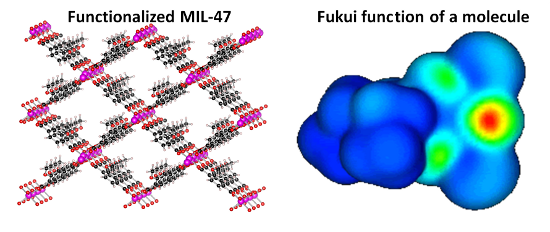Reactivity in MOFs: chemical concepts at work at the border between solids and molecules
Reactivity in MOFs: chemical concepts at work at the border between solids and molecules
Promotor(en): T. Verstraelen, D.E.P. Vanpoucke /15_NANO18 / Nanoporous materialsMetal-organic frameworks (MOFs) have, over the last few decades, emerged as a class of highly tuneable crystalline materials that show ultrahigh porosity (typically 50% and more) and very large internal surface areas (typically 1000 to 10.000m²/g). These materials consist of two secondary building units: (1) metal or metal-oxide centres connected through (2) organic linker molecules. The variability of these inorganic and organic components allows an almost infinite set of possible combinations, each with their own specific properties. Their hybrid nature, combining the crystallinity of solids with supra-molecular interactions between the linkers makes them an ideally suited playing field for the use of chemical concepts in solid state materials. The large internal surface area of a MOF makes it of great interest for catalytic and sorption applications, as such understanding their reactivity and knowledge of their preferential active sites is of importance.

In chemistry, such understanding comes from reactivity indices. They are used to indicate the preference for a site to react with nucleophilic or electrophilic reagents. Within the (conceptual) density functional theory (DFT) framework, the Fukui function is such an index, and has been studied in depth for molecular systems. Other reactivity indices are the local hardness and softness, of which the latter is shown to be related to the local Fukui function. In addition to just indicating preferential sites, reactivity indices can also be used to quantify the effect of variations in the underlying structure (in case of MOFs: the metal cluster or linker used, large/narrow pore geometry). In this thesis project, the student will implement the Fukui function and its’ condensed version into existing in-house simulation software (HIVE). He/she will develop methods for the analysis of the resulting data in a qualitative and quantitative fashion. The implemented method will then be used for the investigation of reactivity in flexible MOFs, of the MIL-53 type, focusing on the role of the metal clusters.
Interested students will be trained in the use of the required quantum mechanical codes and tools necessary for this topic. Necessary programming skills will be acquired during the project.
- Study programmeMaster of Science in Engineering Physics [EMPHYS], Master of Science in Chemistry [CMCHEM], Master of Science in Physics and Astronomy [CMFYST]ClustersFor Engineering Physics students, this thesis is closely related to the cluster(s) Fundamentals, Materials, Nano

